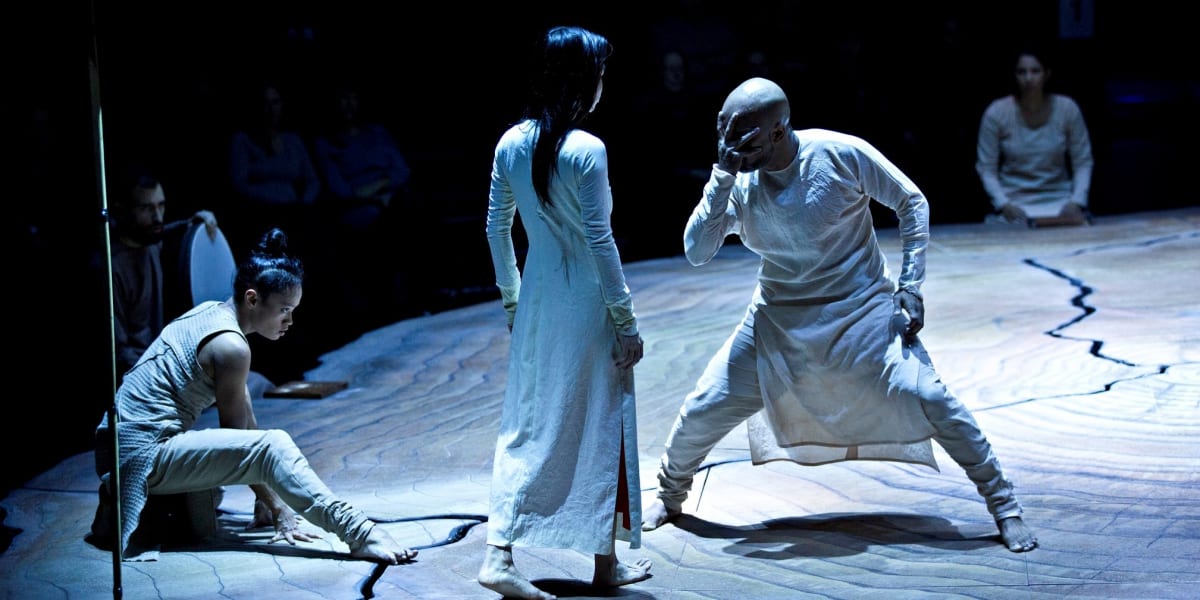‘Until the Lions’ was originally designed for performance at the Roundhouse where it experienced notable success in 2016. It is an epic narrative for three dancers and four singer-musicians, lasting only an hour, but within that period crossing a huge range of emotions and events wholly appropriate to its classic source material, one of the key stories from the ‘Mahabharata’.
This work is one of the major achievements of the Akram Khan dance company in that it embodies the fusion of the classical north Indian dance tradition known as ‘Kathak’ with a modern western dance vocabulary that is the hallmark of their style and of their founder’s originality. It shows his key collaborators in lighting, set design and music at the top of their collective game, while also showcasing dancers who have been central to the artistic success of the company, notably Akram Khan himself, in what will be one of his last performances in a lead role.
As you take your seat the circular set confronts you: a low-rise tree stump with many rings, truly theatre in the round. Vapours rise, miscellaneous wooden staves are embedded in the cracks of the tree, and a deity’s head lies on the ground. As the lights go down four musicians take up places around the central ring, and three dancers gradually emerge from the gloom….
This is a reworking of the story of Amba (Ritter) who is later reincarnated as Shikandi (Chien) and her tortured relationship with Bheeshma (Khan), who abducts her from her wedding, then releases her but then will not marry her because of his own vow of celibacy. Amba finally, after a long quest, achieves her revenge when her reincarnation defeats and kills Bheeshma who dies thus bringing the long war to an end.
It goes without saying that there is individual virtuosity from all three performers, with solos of great complexity and endurance that evoke the raw, primal drive of the ‘Rite of Spring’, but what impresses above all is the quality of the storytelling which is engrossing throughout. There is as much emphasis on the expressivity of the face as on the proficiency and power of arms and legs. There are parallels here with ‘flamenco’ in both the emotional intensity, and obsessive rhythmic patterning of the movements of the feet and arms, and in the narrative drive above all. The attention to detail is striking too, how gestures of oppression, such as a foot placed on a hand, are transferred from Bheeshma to Amba as the action proceeds, and the balance of power shifts.
Moving beyond the drama itself to its setting, the regular collaborators in the Akram Khan company ensure that lighting, design and music combine to enrich and envelop the central action. The music, composed by Vincenzo Lamagna, starts as a recorded sound-track, merely a percussive underscore to the movement, full of edgy acoustic and electronic sounds; but it then grows to show immense expressive variety, instrumental and vocal. As the complexity of the dance combinations gathers, so do the sound textures accumulate – guitar, four-part vocal chorale, traditional Indian chant, and instrumental melody all playing their part, with especially notable contributions from David Azuraza across an astonishing vocal range. David Yip’s design concept and the virtuosic lighting effects created by Michael Hulls create some graphic visual tableaus, perhaps most notably the final one in which the bamboo poles that form such an integral aspect of Khan’s choreographic vocabulary accumulate on stage as a final bed of arrows on which Bheeshma dies, while the tree stump podium rises and splits under a stark flood of focused lighting.
We inevitably judge adaptations of the ‘Mahabharata’ against the magisterial work of Peter Brook who first found a way of presenting both the individually poignant and the timeless, abstract elements of this epic in dramatic union. Akram Khan’s creation finds that same balance using different means, and also adds an emphasis of its own bound up in the signature Ugbo proverb: ‘Until the lions have their own historians, the history of the hunt will always glorify the hunter.’ The determination to focus on how warfare makes victims of all its participants, and the way it brings out unsuspected layers of betrayal and courage and loyalty serves to create a work of lasting worth and thought-provoking imagistic potency.

